
应用化学 ›› 2023, Vol. 40 ›› Issue (2): 188-209.DOI: 10.19894/j.issn.1000-0518.220175
贫电解液下电催化剂对调控锂硫电池性能的研究进展
- 1.河北工业大学能源与环境工程学院,天津 300401
2.河北工业大学化工学院,天津 300401
-
收稿日期:2022-05-10接受日期:2022-08-04出版日期:2023-02-01发布日期:2023-02-27 -
通讯作者:甄蒙蒙,沈伯雄 -
基金资助:国家自然科学基金(51702236);河北省自然科学基金(B2021202052)
Research Progress of Controlling Lithium-Sulfur Batteries by Electrocatalysts under Lean Electrolyte Conditions
Lu-Fei WANG1, Meng-Meng ZHEN1( ), Bo-Xiong SHEN2(
), Bo-Xiong SHEN2( )
)
- 1.School of Energy and Environmental Engineering,Hebei University of Technology,Tianjin 300071,China
2.School of Chemical Engineering and Technology,Hebei University of Technology,Tianjin 300071,China
-
Received:2022-05-10Accepted:2022-08-04Published:2023-02-01Online:2023-02-27 -
Contact:Meng-Meng ZHEN,Bo-Xiong SHEN -
About author:shenbx@hebut.edu.cn
zhenmengmeng@hebut.edu.cn;
-
Supported by:the National Natural Science Foundation of China(51702236);the Natural Science Foundation of Hebei Province(B2021202052)
摘要:
锂硫电池具有高理论能量密度(2600 Wh/kg)和高理论比容量(1675 mA·h/g),被视为最有可能替代锂离子电池实现商业应用的电化学储能系统之一。然而,锂硫电池所固有的缓慢氧化还原动力学和多硫化物的“穿梭效应”等问题严重影响了锂硫电池的循环性能以及循环寿命。目前,大部分综述主要集中于过量电解液下锂硫电池硫主体材料的设计制备方面,对贫电解液下锂硫电池性能的研究关注较少。基于此,本文介绍了贫电解液下不同电催化剂对锂硫电池氧化还原反应动力学和电化学性能的调控,主要分为非金属催化剂和金属催化剂两类,其中非金属催化剂包括非金属化合物、石墨烯、碳纳米管以及杂原子掺杂碳材料;金属催化剂包括钴基催化剂、钼基催化剂、铁基催化剂以及多金属基异质结构。最后,对推动锂硫电池实现商业应用需要进一步开展的研究提出了思考并进行了展望。
中图分类号:
引用本文
王路飞, 甄蒙蒙, 沈伯雄. 贫电解液下电催化剂对调控锂硫电池性能的研究进展[J]. 应用化学, 2023, 40(2): 188-209.
Lu-Fei WANG, Meng-Meng ZHEN, Bo-Xiong SHEN. Research Progress of Controlling Lithium-Sulfur Batteries by Electrocatalysts under Lean Electrolyte Conditions[J]. Chinese Journal of Applied Chemistry, 2023, 40(2): 188-209.

图1 (A)非水LSBs的典型充放电曲线[14]; (B)LSBs充放电过程中催化剂的作用机理示意图[15]
Fig.1 (A) Typical charge-discharge curves for non-aqueous LSBs[14]; (B) Illustration of the catalytic mechanism during charge-discharge process in LSBs[15]

图2 (A)以4000?r/min离心的BP透射电子显微镜(TEM)图像; (B)以8000?r/min (BP-8K) 离心的BP TEM图像; (C)高分辨率TEM (HRTEM) BP-8K的图像和相应的选区电子衍射(SAED)图像(插图); (D-F)BPQDs的TEM和HRTEM图像; (G)块体BP的拉曼光谱(红色)和硅(Si)衬底上的BPQD(蓝色); (H)在1.7和2.8 V之间0.1 C时正极的初始放电-充电曲线; (I)PCNF/S/BPQD在0.1 C下循环200次的性能[47]
Fig.2 (A) Transmission electron microscopy (TEM) image of black phosphorus (BP) that is centrifuged at 4000 r/min; (B) TEM image of BP centrifuged at 8000 r/min (BP-8K); (C) High-resolution TEM (HRTEM) image and corresponding selected area electron diffraction (SAED) pattern (inset) of BP-8K; (D-F) TEM and HRTEM images of BPQDs; (G) Raman spectra of bulk BP (red) and BPQD (blue) on a silicon (Si) substrate; (H) Initial discharge-charge profiles at 0.1 C between 1.7 and 2.8 V vs.Li+/Li; (I) Cyclic performance of the PCNF/S/BPQD at 0.1 C for 200 cycles; (porous carbon nanofibers,PCNFs)[47]
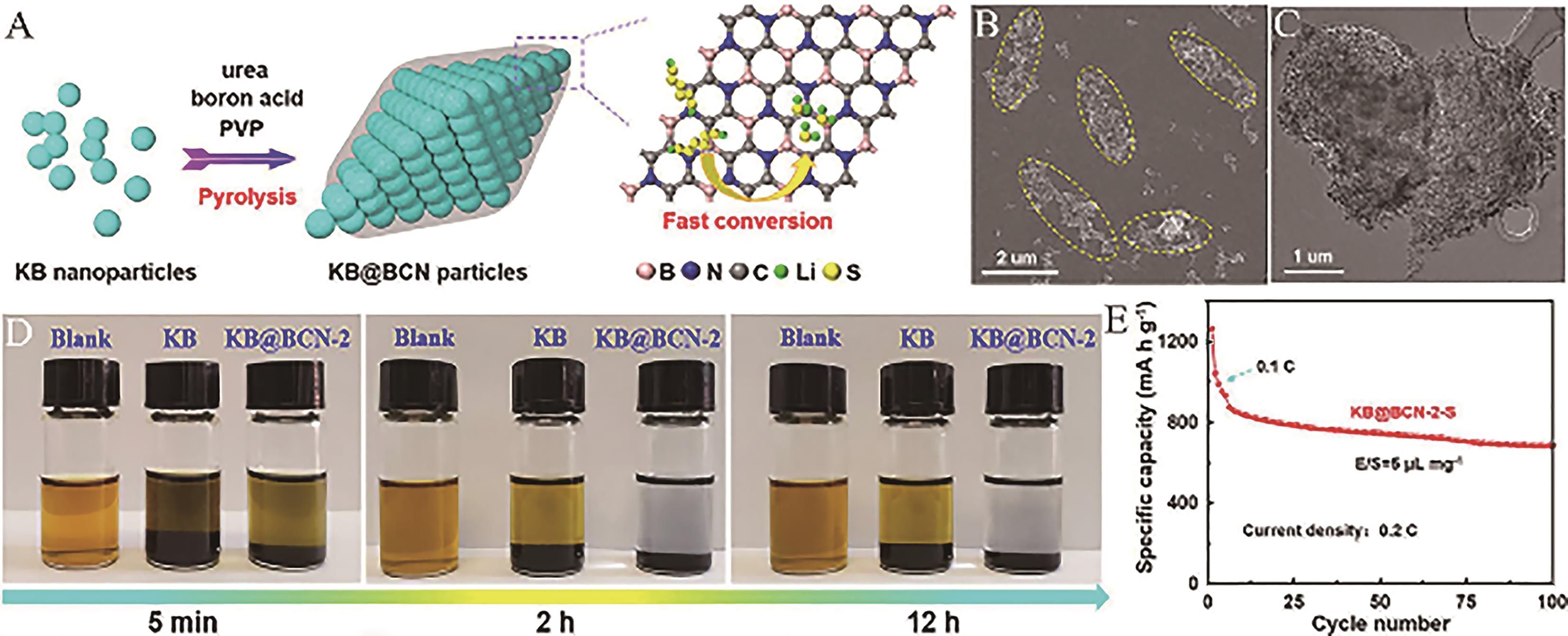
图3 (A)多孔碳@硼碳氮化物(KB@BCN)的合成过程示意图; (B)KB@BCN-2的SEM图像和(C)TEM图像; (D)Li2S6溶液(0.003 mol/L)与KB@BCN-2和KB之间吸附实验的光学照片; (E) KB@BCN-2-S在0.2 C和低E/S=5 μL/mg时的循环性能[53]
Fig.3 (A) Schematic illustration of the synthesis process of porous carbon@borocarbonitride (KB@BCN); (B) SEM and (C) TEM images of KB@BCN-2; (D) Optical photographs of an adsorption experiment between Li2S6 solution (0.003 mol/L) and KB@BCN-2 or KB; (E) Cycle performance of KB@BCN-2-S at 0.2 C with a low E/S=5 μL/mg[53]
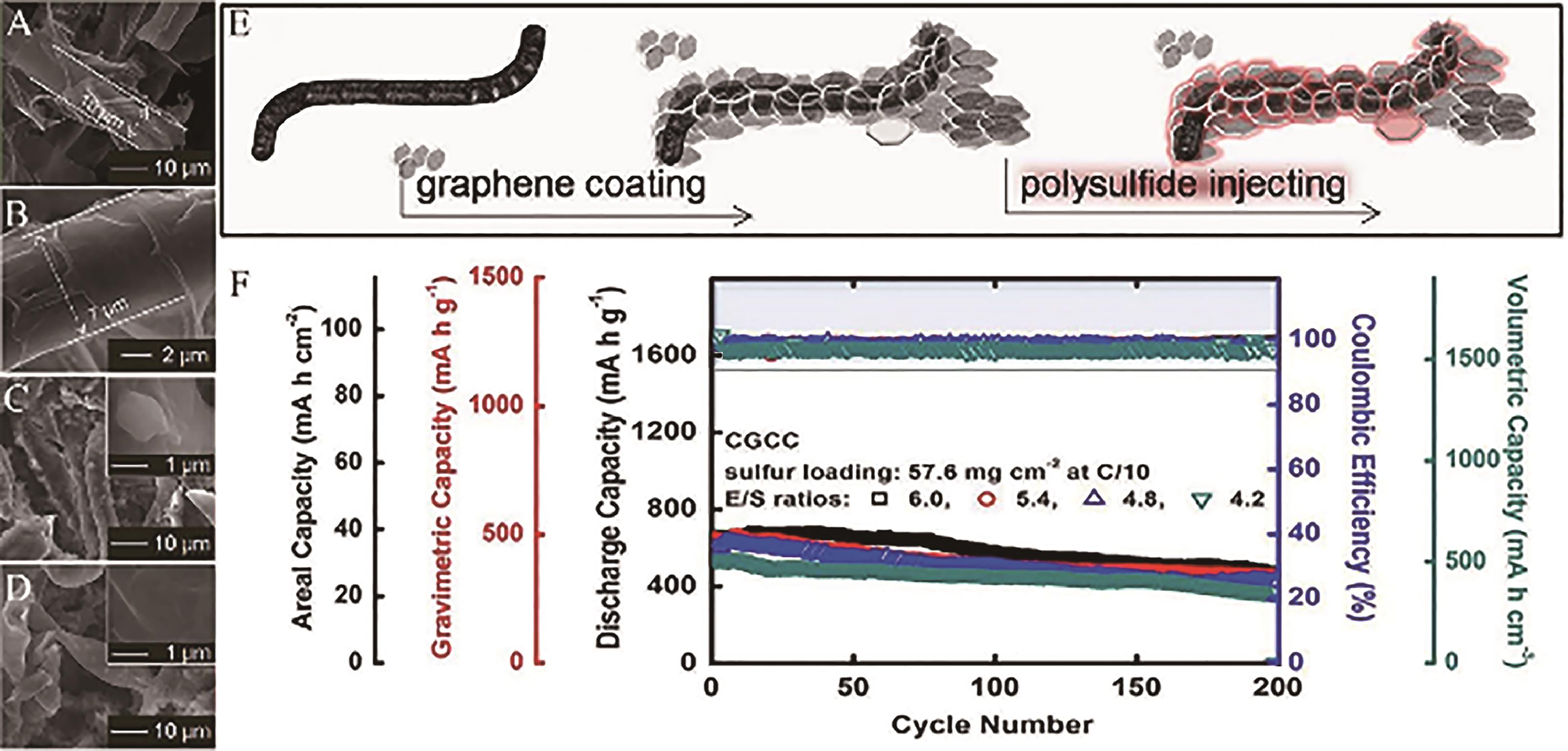
图4 (A)CGCC的低倍S和(B)高倍SEM图像; (C)CGCC正极的SEM图像; (D)循环CGCC正极的SEM图像; (E)CGCC正极的合成路线图; (F)CGCC正极的循环性能[49]
Fig.4 (A) Low-magnification S and (B) high-magnification SEM images of CGCC; (C) SEM images of CGCC cathode; (D) SEM images of cycled CGCC cathodes; (E) Illustration of the synthesis route of the CGCC cathode; (F) Cyclability performance of CGCC cathodes[49]
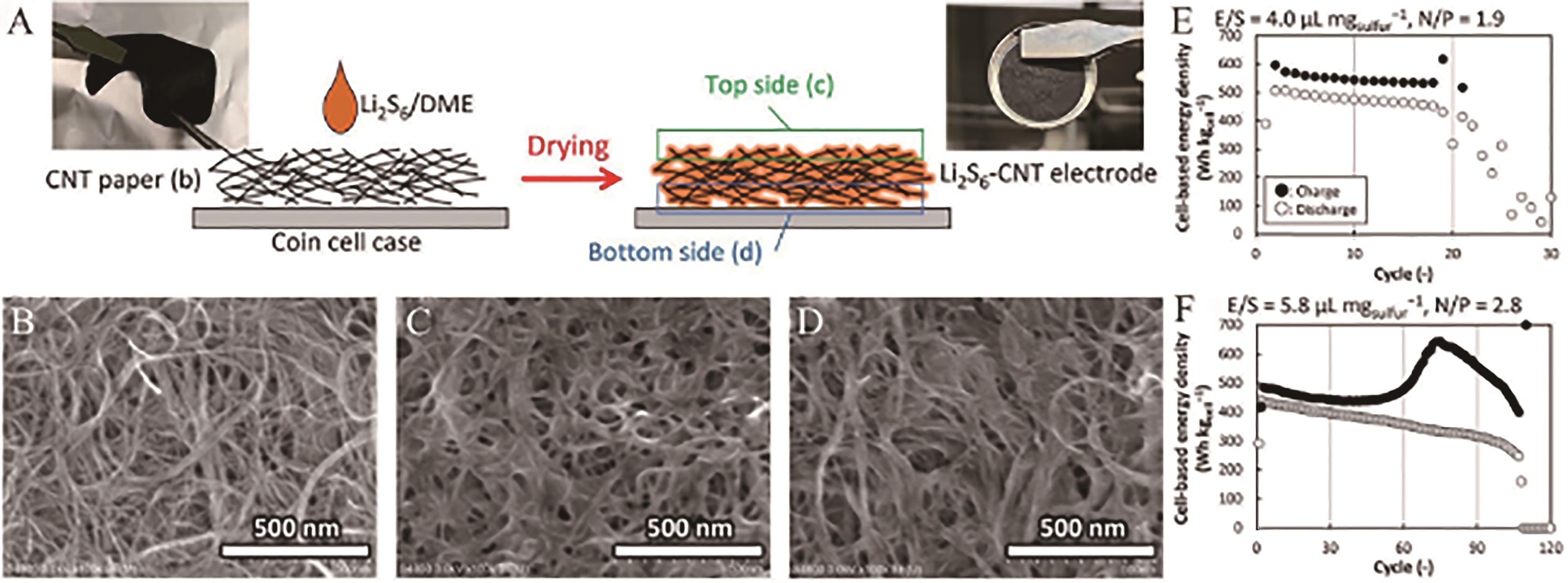
图5 (A)CNT纸和Li2S6-CNT电极的示意图和数码图像; (B)CNT纸的SEM图像和(C、D)Li2S6-CNT电极顶部(c)和底部(d)的SEM图像; (E)和(F)Li||Li2S6 -CNT全电池的能量密度[56]
Fig.5 (A) Schematic and digital images of the CNT paper and the Li2S6-CNT electrode; SEM images of (B) the CNT paper and (C, D) the Li2S6-CNT electrode from the top (c) and the bottom (d); Energy density of the Li||Li2S6-CNT full cells shown in (E) and (F) [56]
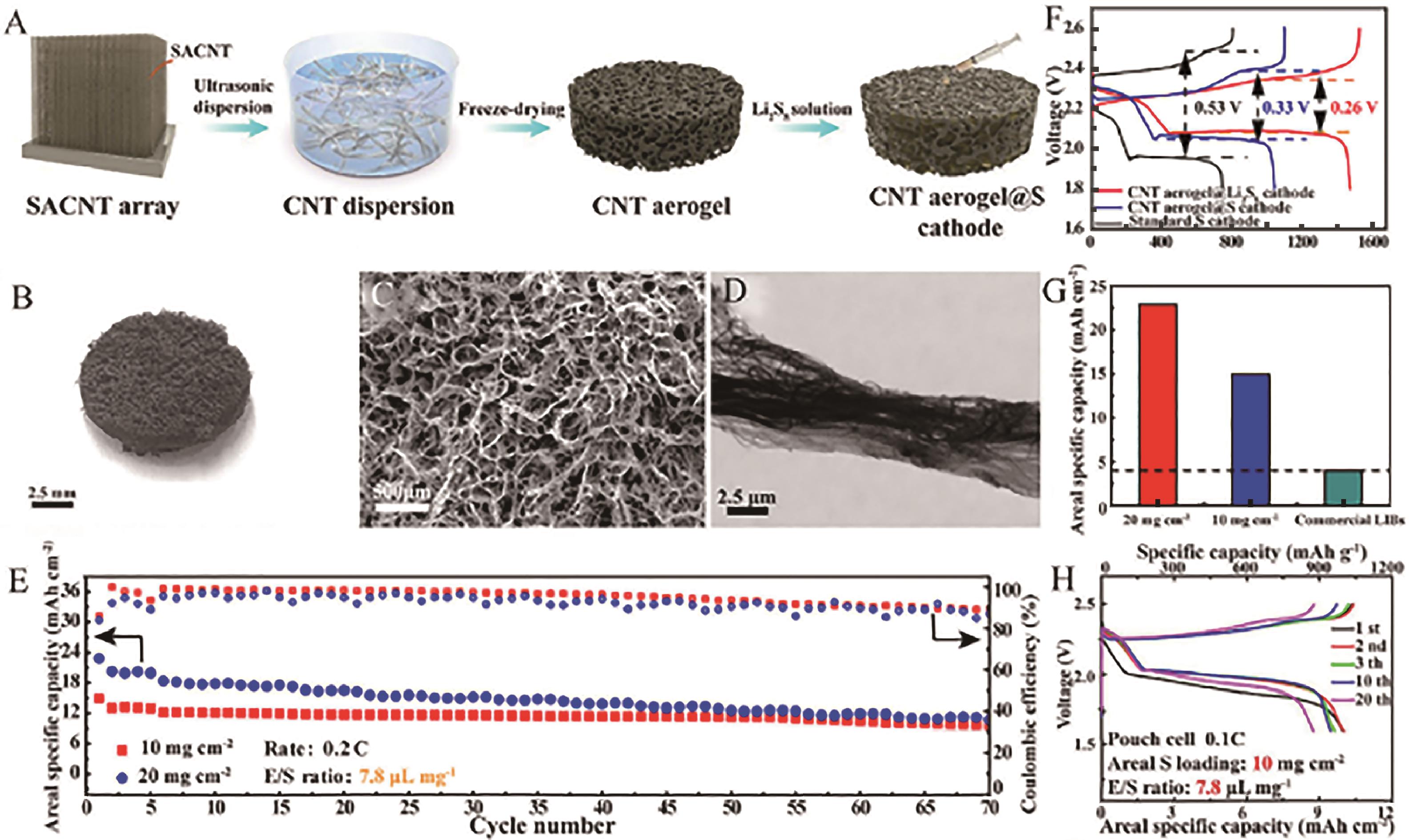
图6 (A)CNT气凝胶@Li2S8正极的制造过程示意图; (B)CNT气凝胶的数码照片; (C、D)CNT气凝胶@Li2S8正极的SEM图像; (E)CNT气凝胶@Li2S8正极在0.2 C时具有高S负载的面积比容量; (F)不同正极的电压曲线; (G)与商业LIBs相比,高硫负载的CNT气凝胶@Li2S8正极的面积比容量; (H)CNT气凝胶@Li2S8软包电池在0.1 C下的充电和放电曲线[57]
Fig.6 (A) Schematic of the fabrication process of a CNT aerogel@Li2S8 cathode; (B) Digital photo of a CNT aerogel; (C, D) SEM images of a CNT aerogel@Li2S8 cathode; (E) CNT aerogel@Li2S8 cathode with high S loading area specific capacity at 0.2 C; (F) Voltage profiles of different cathodes; (G) Areal specific capacities of the CNT aerogel@Li2S8 cathodes with high S loadings compared to commercial LIBs; (H) Charge and discharge curves of a CNT aerogel@Li2S8 pouch cell at 0.1 C[57]

图7 (A)NCNF和(B)VNCNF的SEM图像; (C)和(D)VNCNFs的TEM图像; (E)不对称双功能VNCNFs膜合成过程和S/VNCNFs||VNCNFs/Li全电池配置的示意图; (F)S/VNCNFs||VNCNFs/Li全电池在硫负载量为8.3 mg/cm2时的长循环寿命;(G)S/VNCNFs||VNCNFs/Li全电池在1 mA/cm2和15.27 mg/cm2的高硫负载量时的面积比容量。(Li-S,锂硫;PECVD,等离子体增强化学气相沉积;SEM,扫描电子显微镜)[60]
Fig.7 SEM images of (A) NCNFs and (B) VNCNFs; (C) and (D) TEM images of VNCNFs; (E) Schematic illustration of the synthetic process of asymmetric bifunctional VNCNFs membrane and diagram of the S/VNCNFs||VNCNFs/Li full cell configuration; (F) The long-term cycle life of the S/VNCNFs||VNCNFs/Li full cell with a sulfur load of 8.3 mg/cm2; (G) The areal capacity of the S/VNCNFs||VNCNFs/Li full cell with a high sulfur load of 15.27?mg/cm2 at 1 mA/cm2. (Li-S, lithium-sulfur; PECVD, plasma-enhanced chemical vapor deposition; SEM, scanning electron microscopy)[60]

图8 (A)S@WLC-CNTs电极的合成过程示意图; (B-D)WLC-CNTs主体的SEM图像; (E)硫负载量为17.3 mg/cm2的S@WLC-CNTs正极的SEM图像; (F-G)不同厚度和硫质量的S@WLC-CNTs电极在0.1 C下的循环性能[62]
Fig.8 (A) Schematic illustration of the synthesis process of S@WLC-CNTs electrodes; (B-D) SEM images of the WLC-CNTs host; (E) SEM image of the S@WLC-CNTs cathode with sulfur loading of 17.3 mg/cm2; (F-G) Cyclability of S@WLC-CNTs electrodes with different thicknesses and sulfur content at the 0.1 C[62]
| Material | E/S ratio (μL·mg-1) | Sulfur loading/ (mg·cm-2) | Current/number of cycles | Discharge capacity/ (mA·h·g-1) | Area capacity/ (mA·h·cm-2) | Ref. |
|---|---|---|---|---|---|---|
| PCNF/S/BPQDs | 6.5 | 8.0 | 0.1 C/200 | 550 | 4.4 | [ |
| KB@BCN-2-S | 5.0 | 4.0 | 0.2 C/100 | 677 | 2.7 | [ |
| CGCC | 4.2 | 57.6 | 0.1 C/200 | 539 | 31.0 | [ |
| HCFF-S | 3.53 | 21.2 | 3.55 (mA/cm2)/150 | 698 | 14.8 | [ |
| CNTaerogel@Li2S8 | 7.8 | 20.0 | 0.2 C/70 | 535 | 10.7 | [ |
| S/NF@VG | 4.8 | 13.0 | 0.1 C/100 | 846 | ~11 | [ |
| S/VNCNFs||VNCNFs/Li | 4.0 | 15.27 | 1.0 (mA/cm2)/50 | 851 | 13.0 | [ |
| S@WLC-CNTs | 6.0 | 52.4 | 0.1 C/100 | 692 | 36.2 | [ |
表1 非金属催化剂在贫电解液LSB中的电化学性能总结
Table 1 The electrochemical performance of nonmetallic catalysts in LSB under lean electrolyte
| Material | E/S ratio (μL·mg-1) | Sulfur loading/ (mg·cm-2) | Current/number of cycles | Discharge capacity/ (mA·h·g-1) | Area capacity/ (mA·h·cm-2) | Ref. |
|---|---|---|---|---|---|---|
| PCNF/S/BPQDs | 6.5 | 8.0 | 0.1 C/200 | 550 | 4.4 | [ |
| KB@BCN-2-S | 5.0 | 4.0 | 0.2 C/100 | 677 | 2.7 | [ |
| CGCC | 4.2 | 57.6 | 0.1 C/200 | 539 | 31.0 | [ |
| HCFF-S | 3.53 | 21.2 | 3.55 (mA/cm2)/150 | 698 | 14.8 | [ |
| CNTaerogel@Li2S8 | 7.8 | 20.0 | 0.2 C/70 | 535 | 10.7 | [ |
| S/NF@VG | 4.8 | 13.0 | 0.1 C/100 | 846 | ~11 | [ |
| S/VNCNFs||VNCNFs/Li | 4.0 | 15.27 | 1.0 (mA/cm2)/50 | 851 | 13.0 | [ |
| S@WLC-CNTs | 6.0 | 52.4 | 0.1 C/100 | 692 | 36.2 | [ |
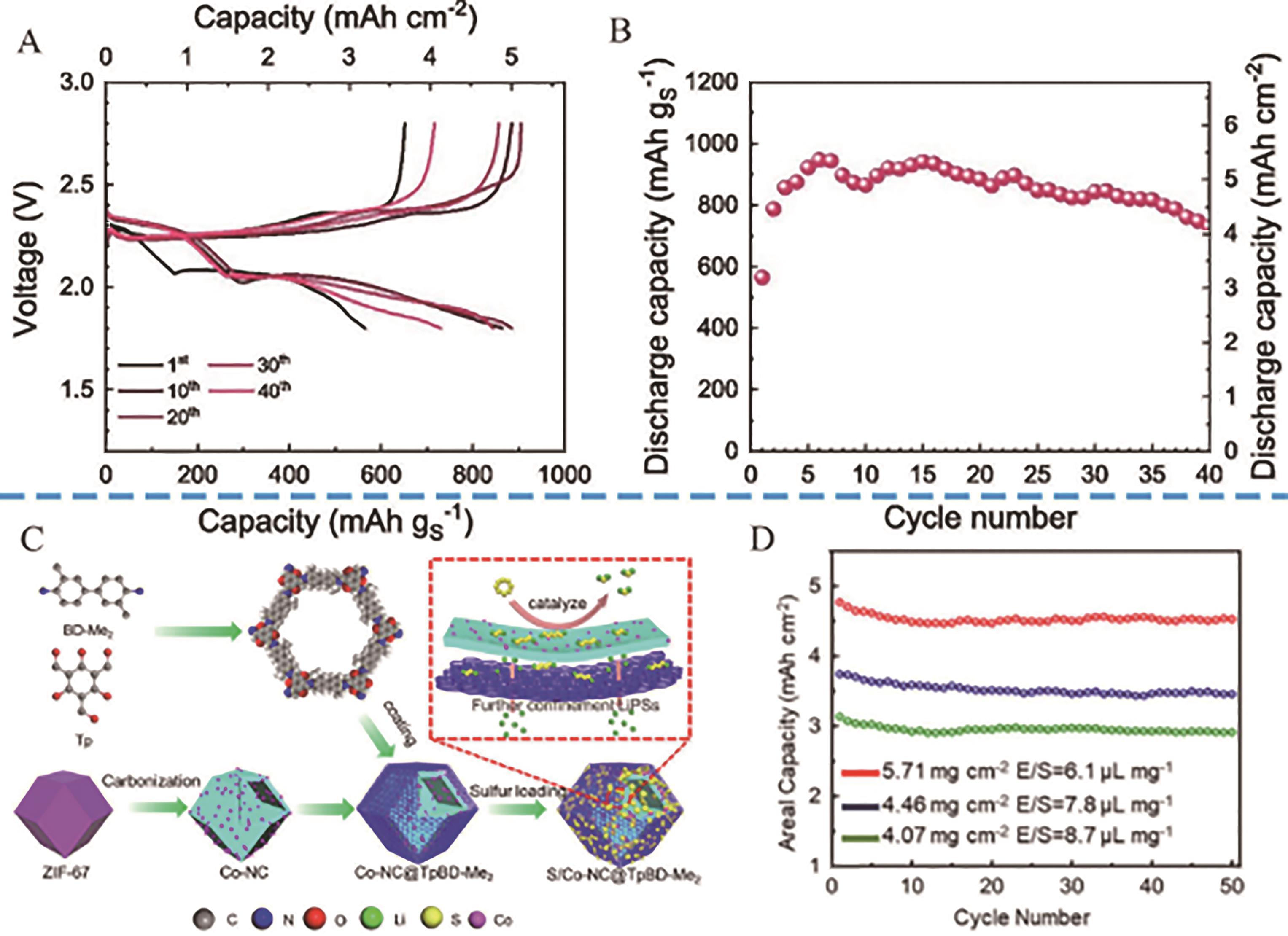
图9 电极硫负载量为5.7 mg/cm2和E/S比为5 μL/mg的Li|S∶Au 97∶3 (m/m)电池在C/20恒流速率下的(A)电压曲线和(B)循环性能[67]; (C)Co-NC@TpBD-Me2正极的制备过程及其作为硫正极的工作机理; (D) S/Co-NC@TpBD-Me2正极在0.2 C和高硫负载下的循环[69]
Fig.9 (A) Voltage profiles and (B) cycling trend at the constant current rate of C/20 of the Li|S∶Au 97∶3(m/m) cell with sulfur loading over the electrode of 5.7 mg/cm2 and E/S ratio of 5 μL/mg[67]; (C) Preparation procedure of Co-NC@TpBD-Me2 cathode and its working mechanism as sulfur cathode; (D) Cycling of S/Co-NC@TpBD-Me2 cathode at 0.2 C under high sulfur loadings[69]

图10 (A)带DEB位点的大孔宿主设计策略; (B)Li2S4、Li2S6和Li2S8在ZnS表面(a1-a3)、Co-N-C表面(b1-b4)和ZnS,Co-N-C表面(c1-c4)上的优化配置; 黄、粉、银、棕、蓝和青球分别表示S、Li、Zn、Co、N和C原子; 具有ZnS和Co-N-C DEB位点的3D有序大孔硫主体(“3d-omsh/ZnS、Co-N-C”)[71]
Fig.10 (A) Design strategy of macroporous host with DEB sites; (B) Optimized configurations of Li2S4, Li2S6 and Li2S8 absorption on ZnS (a1-a3), the Co-N-C surface (b1-b4) and the ZnS, Co-N-C surface (c1-c4); The yellow, pink, silver, brown, blue and cyan balls denote the S, Li, Zn, Co, N and C atoms, respectively; The 3D ordered macroporous sulfur host with ZnS and Co-N-C DEB sites (“3d-omsh/ZnS,Co-N-C”)[71]
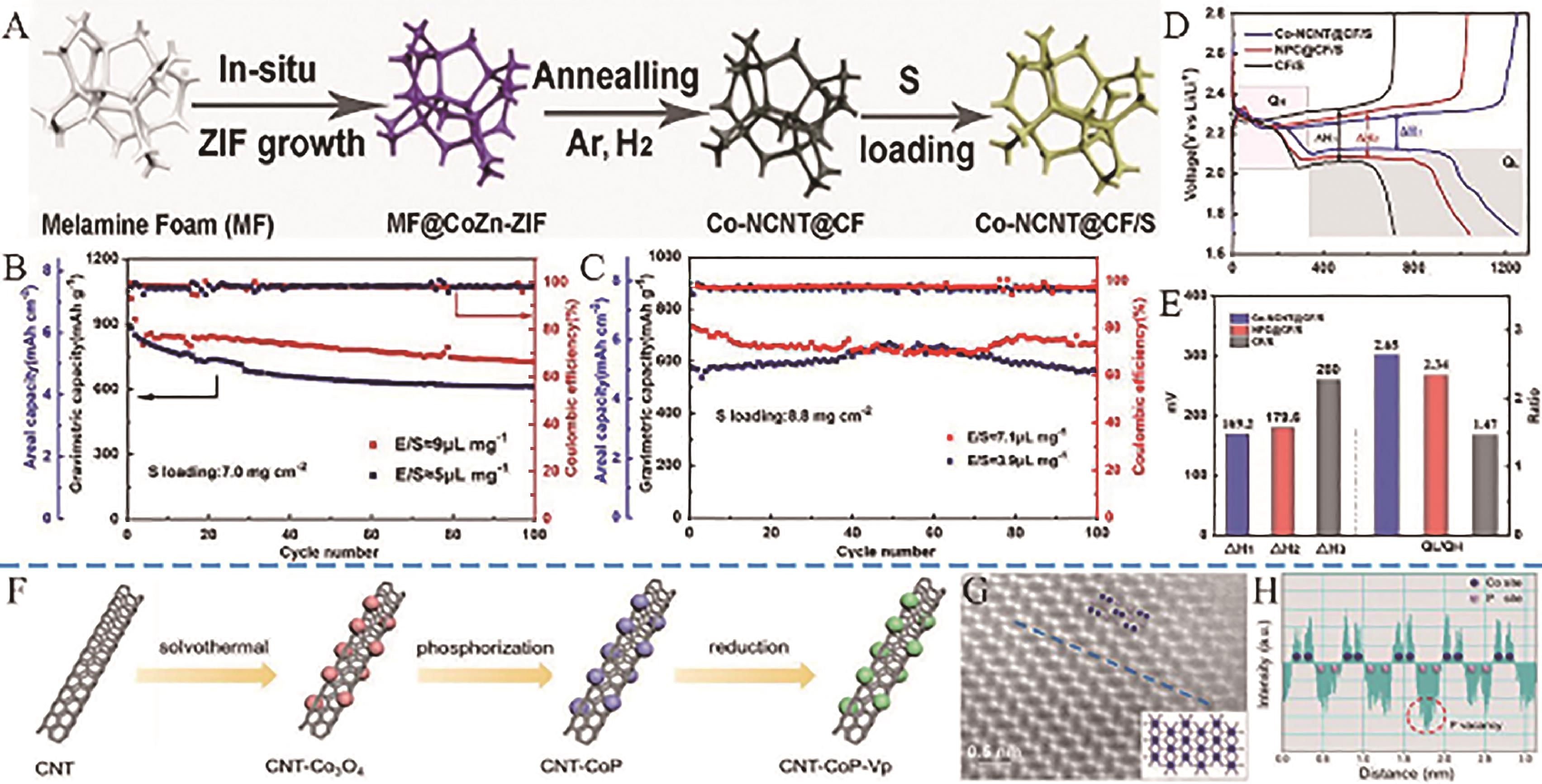
图11 (A) Co-NCNT@CF/S的合成过程示意图; (B)Co-NCNT@CF/S电极在0.1?C时不同E/S比下的循环性能; (C)Co-NCNT@CF/S正极在0.1 C的循环性能; (D)不同电极在0.1?C电流速率下的初始充放电曲线; (E)从充电/放电曲线计算的ΔH和QL/QH值[73]; (F)CNT-CoP-Vp合成示意图; (G)CNT-CoP-Vp-1M的STEM-HADDF图像,插图是CoP的理论模型; (H)沿(G)中蓝色虚线的Co和P原子柱的强度[75]
Fig.11 (A) Schematic diagrams of the synthetic procedure of Co-NCNT@CF/S; (B) Cycling performance of Co-NCNT@CF/S electrode under different E/S ratios at 0.1?C; (C) The cycling performance of the Co-NCNT@CF/S cathode at 0.1 C; (D) Initial charge-discharge profiles of different electrodes with a 0.1?C current rate; (E) Values of ΔH and QL/QH calculated from the charge/discharge curves[73]; (F) Schematic illustration of the synthesis of CNT-CoP-Vp; (G) STEM-HADDF image of CNT-CoP-Vp-1M, the insert image is the theoretical model of CoP; (H) The intensity of Co and P atomic columns along blue dotted line in (G) [75]
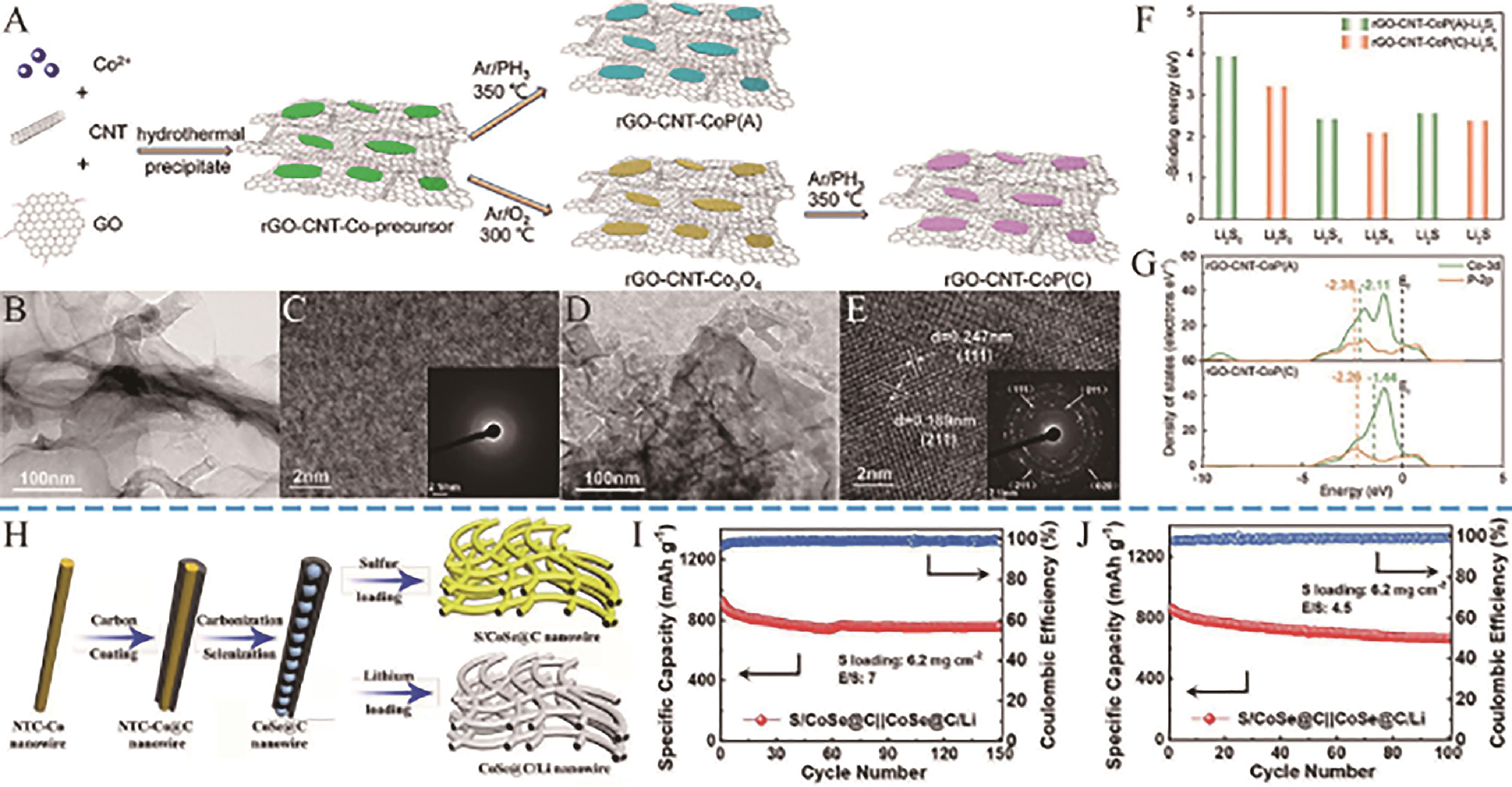
图12 (A) rGO-CNT-CoP(A)和rGO-CNT-CoP(C)的制备示意图; (B、C) rGO-CNT-CoP(A)的TEM、HRTEM图像; (D、E) rGO-CNT-CoP(C)的TEM、HRTEM图像; (F) Li2S6、Li2S4和Li2S在rGO-CNT-CoP(A)和rGO-CNT-CoP(C)上的结合能; (G)Co的d带和P的p带的状态密度[76]; (H) S/CoSe@C和CoSe@C/Li的合成路线示意图; (I) S/CoSe@C||CoSe@C/Li电池在0.2 C倍率下的循环稳定性; (J) S/CoSe@C||CoSe@C/Li电池在0.1 C倍率下的循环稳定性。氨三乙酸(NTC)[78]
Fig.12 (A) Schematic Illustration of the Fabrication of rGO-CNT-CoP(A) and rGO-CNT-CoP(C) Composite; (B, C) TEM, HRTEM images of rGO-CNT-CoP(A); (D, E) TEM, HRTEM images of rGO-CNT-CoP(C); (F) Binding energies of Li2S6, Li2S4, and Li2S on rGO-CNT-CoP (A) and rGO-CNT-CoP (C); (G) Density of states of d bands of Co and p bands of P[76]; (H) Schematic of the synthesis route for S/CoSe@C and CoSe@C/Li; (I) Cycling stability of the S/CoSe@C||CoSe@ C/Li cell at 0.2 C rate; (J) Cycling stability of the S/CoSe@C||CoSe@C/Li cell at 0.1 C rate. Nitrilotriacetic acid (NTC)[78]

图13 (A)Li2S-Co9S8/Co在LSBs中的优势示意图; (B)Li2S-Co9S8/Co正极在1 C倍率下的循环稳定性; (C)Li2S-Co9S8/Co正极在0.1 C倍率下具有各种Li2S负载的循环稳定性; (D)Li2S-Co9S8/Co-Te正极在Ni||Li2S软包电池中的循环稳定性[81]
Fig.13 (A) Schematic illustration of the advantages of Li2S-Co9S8/Co in LSBs; (B) Cycling stability of the Li2S-Co9S8/Co cathode at 1 C rate; (C) Cycling stability of the Li2S-Co9S8/Co cathode with various Li2S loadings at 0.1 C rate; (D) Cycling stability of the Li2S-Co9S8/Co-Te cathode in the Ni||Li2S pouch cell[81]

图14 (A) MoB的制造过程示意图; (B、C) MoB的低倍TEM图像; (D) MoB的HRTEM图像; (E)催化电极在LSBs中的优势示意图; (F) MoB/S正极在0.2 C倍率时的循环性能; (G)比较MoB/S和C/S正极以C/20的速率在E/S比为4.5 μL/mg和硫负载量为3.5 mg/cm2的软包电池中的循环稳定性[82]
Fig.14 (A) Schematic diagram of the fabrication process of MoB; (B, C) Low-magnification TEM images of MoB; (D) HRTEM images of MoB; (E) Schematic illustration of the advantages of catalytic electrode in LSBs; (F) Cycling stability of the MoB/S cathode in coin cell at 0.2 C rate; (G) A comparative cycling stability of the MoB/S and C/S cathodes in pouch cells with an E/S ratio of 4.5 μL/mg and a sulfur loading of 3.5 mg/cm2 at C/20 rate[82]

图15 (A) Co-MoSe2/MXene的合成过程示意图; (B-D)S/Co-MoSe2/MXene整体式正极在0.1 C和贫电解液下的电化学性能,(B) E/S为5.0 μL/mg时的长循环稳定性; (C) 100次循环后的重量和体积容量与(D)E/S比为3.5 μL/mg时的面积比容量[90]
Fig.15 (A) Synthesis processes of the schematic illustration of the Co-MoSe2/MXene; (B-D) Electrochemical performance of S/Co-MoSe 2 /MXene monolith cathodes in lean electrolyte at 0.1 C, (B) Long-term cycling stability at the E/S ratio of 5.0 μL/mg; (C) Gravimetric and volumetric capacities and (D) areal capacities at an E/S ratio of 3.5 μL/mg[90]
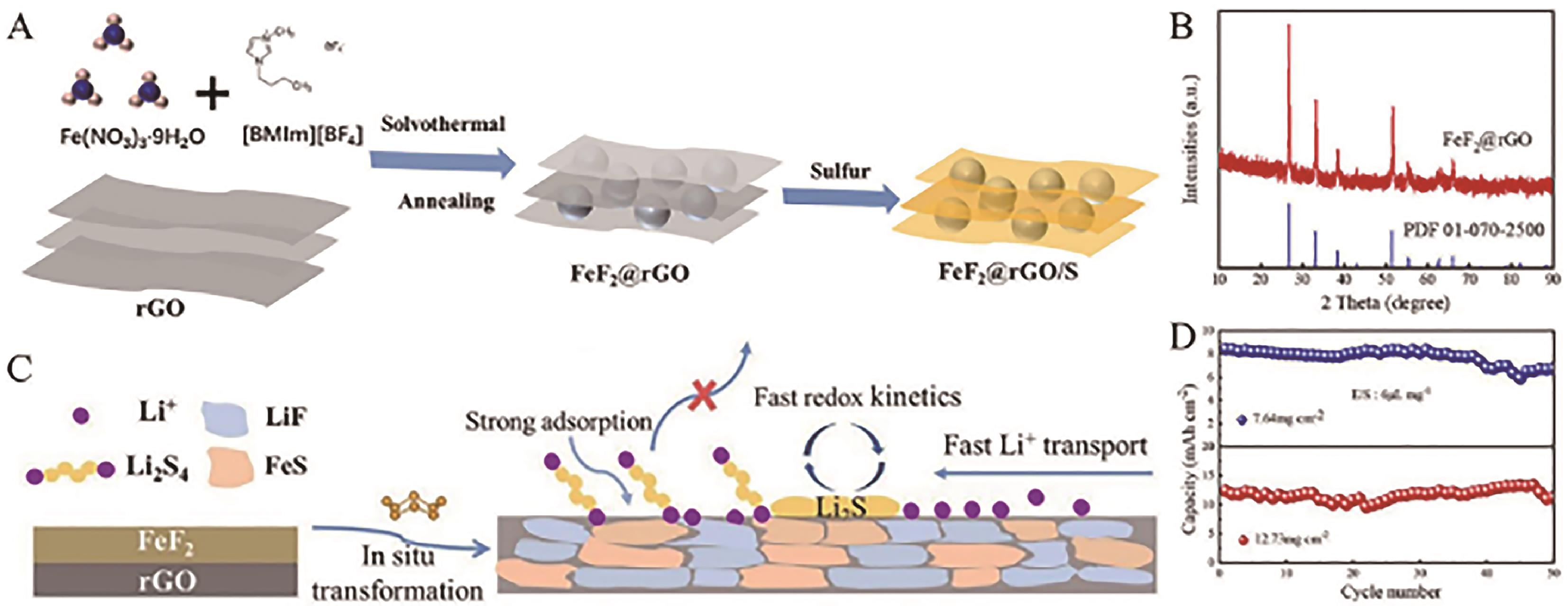
图16 (A) FeF2@rGO合成路线图; (B) FeF2@rGO的XRD图谱; (C)循环过程中正极催化转化过程的示意图; (D) FeF2@rGO正极在0.1 C和高硫负载下循环性能[96]
Fig.16 (A) FeF2@rGO synthetic route diagram; (B) XRD patterns of FeF2@rGO; (C) Schematic diagram of the cathode catalytic conversion process during cycle; (D) Cycling performances of FeF2@rGO cathode and rGO cathode under high sulfur loading at 0.1 C[96]
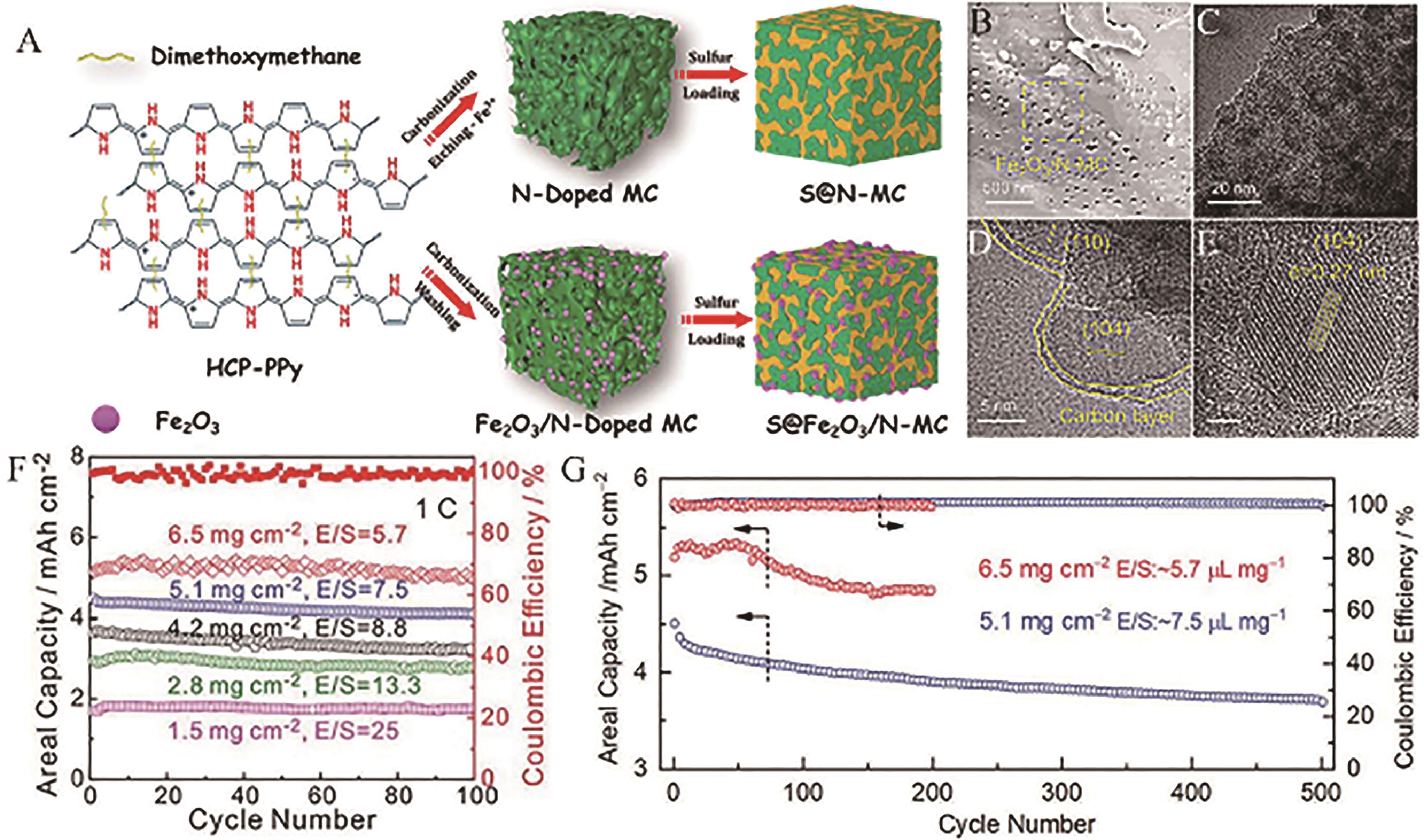
图17 (A) Fe2O3/N-MC、N-MC的合成及其在LSBs中的应用示意图; S@Fe2O3/N-MC的(B)SEM图像和(C)TEM图像以及(D、E)HRTEM图像; (F)S@Fe2O3/N-MC正极在不同E/S比和硫负载量下的短循环性能和(G)在1.0 C和高面积硫负载(5.1和6.5 mg/cm2)下的长循环性能[97]
Fig.17 (A) Schematic illustration for the synthesis of Fe2O3/N-MC, N-MC and their application in LSBs; (B) SEM image and (C) TEM image and (D, E) HRTEM images of S@Fe2O3/N-MC; (F) The short cycling performance of S@Fe2O3/N-MC cathode under different E/S ratio and sulfur loading and (G) long-term cycling performance under high areal loading (5.1 and 6.5 mg/cm2) at 1.0 C[97]
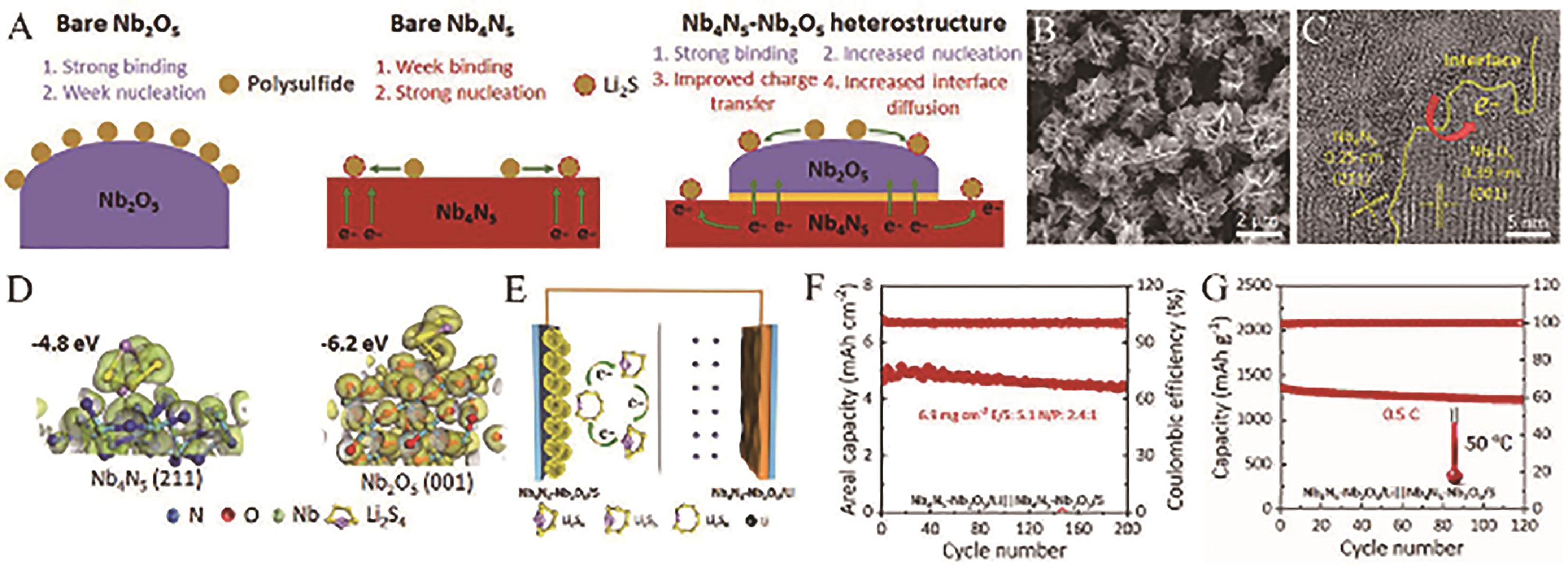
图18 (A) Nb4N5-Nb2O5异质结构的催化机理和(B)SEM图像以及(C)HRTEM图像; (D)Li2S4在Nb4N5(211)和Nb2O5(001)表面上的优化几何形状及其相应的结合能; (E)基于Nb4N5-Nb2O5异质结构的全电池示意图; (F)全电池在0.3 C和6.9 mg/cm2的高硫负载下获得的面积比容量和(G)全电池在50 ℃高温下运行的循环性能[100]
Fig.18 (A) Catalytic mechanism and (B) SEM image and (C) HRTEM image of Nb4N5-Nb2O5 heterostructures; (D) Optimized geometries and their corresponding binding energies of Li2S4 on Nb4N5 (211) and Nb2O5 (001) surfaces; (E) Schematic configuration of Nb4N5-Nb2O5 heterostructures based full batteries; (F) Areal capacity of Nb4N5-Nb2O5/Li||Nb4N5-Nb2O5/S battery obtained at 0.3 C with high sulfur loading of 6.9 mg/cm2 and (G) Cycling performance of the full battery operated at an elevated temperature of 50 ℃[100]
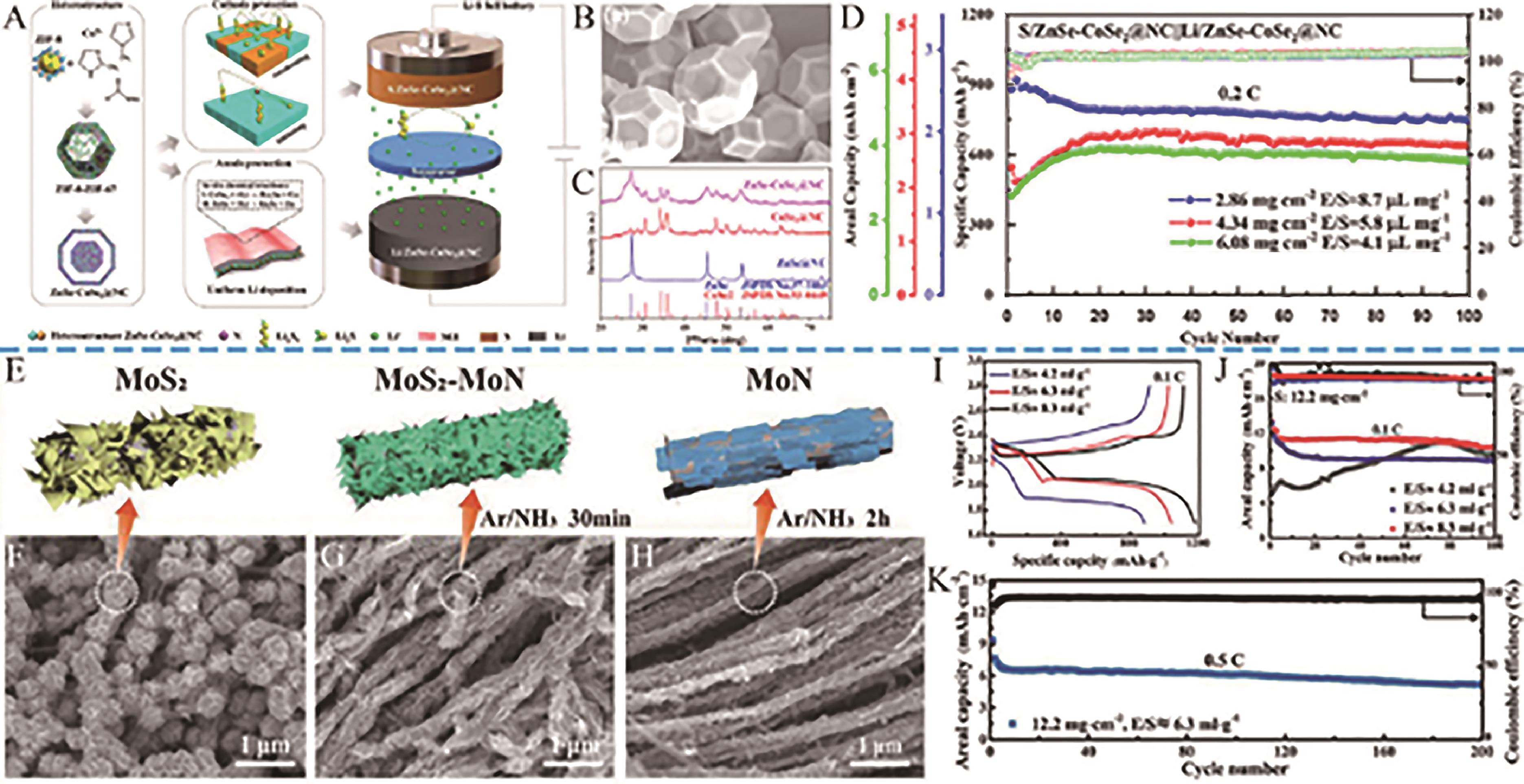
图19 (A)基于“二合一”ZnSe-CoSe2@NC主体的锂硫全电池的工作原理; (B) ZnSe-CoSe2@NC的SEM图像; (C)ZnSe-CoSe2@NC、CoSe2@NC和ZnSe@NC的XRD图; (D)全电池在高硫负载和贫电解液下的循环性能[101]; (E)在NCNT上垂直生长的MoS2、MoS2-MoN和MoN纳米片的示意图; (F)MoS2、(G)MoS2-MoN和(H)MoN主体的SEM图像; (I)硫负载量为12.2 mg/cm2与不同E/S比的恒电流充/放电曲线; (J)硫负载量为12.2 mg/cm2和不同E/S比下MoS2-MoN/S正极在0.1 C循环100次的循环性能; (K)MoS2-MoN/S正极在0.5 C下循环200次的性能[102]
Fig.19 (A) The working principle of the Li-S full battery based on the “two-in-one” ZnSe-CoSe2@NC hosts; (B) SEM images of ZnSe-CoSe2@NC; (C) XRD pattern of ZnSe-CoSe2@NC, CoSe2@NC and ZnSe@NC; (D) Cycle performance of the full cell under high sulfur loading and lean electrolyte[101]; (E) Schematic illustration of MoS2, MoS2-MoN, and MoN nanosheets grown on nitrogen-doped carbon nanotube (NCNT) vertically; SEM images of (F) MoS2, (G) MoS2-MoN and (H) MoN hosts; (I) Galvanostatic charge/discharge curves for different E/S ratios with sulfur loadings of 12.2 mg/cm2; (J) Cycling performances of MoS2-MoN/S cathodes with sulfur loadings of 12.2 mg/cm2 with different E/S ratios at 0.1 C for 100 cycles; (K) Cycling performance of MoS2-MoN/S cathode at 0.5 C for 200 cycles[102]
| Material | E/S ratio/ (μL·mg-1) | Sulfur loading/ (mg·cm-2) | Current/number of cycles | Discharge capacity/ (mA·h·g-1) | Area capacity/ (mA·h·cm-2) | Ref. |
|---|---|---|---|---|---|---|
| m(S)∶m(Au)=97∶3 | 5.0 | 5.7 | 0.05 C/40 | 730 | 4.2 | [ |
| S/Co-NC@TpBD-Me2 | 6.1 | 5.71 | 0.2 C/50 | 793 | 4.53 | [ |
| ZnS and Co-N-C DEB sites | 4.0 | 6.25 | 83.33 (mA/g)/80 | 1 257 | 7.86 | [ |
| Co-NCNT@CF/S | 3.9 | 8.8 | 0.1 C/100 | 579 | 5.10 | [ |
| S/CNT-CoP-Vp | 5.0 | 7.7 | 0.4 (mA/cm2)/30 | 1 043 | 8.03 | [ |
| S/rGO-CNT-CoP(A) | 7.0 | 5.3 | 0.8 (mA/cm2)/50 | 833 | 4.43 | [ |
| S/CoSe@C||CoSe@C/Li | 4.5 | 6.2 | 0.1 C/100 | 680 | 4.2 | [ |
| N-CoSe2/S | 4.4 | 10.2 | 0.2 C/70 | ~790 | ~8.1 | [ |
| Li2S-Co9S8/Co | 5.0 | 8.3(Li2S) | 0.1 C/150 | 653 | - | [ |
| MoB/S | 7.0 | 6.1 | 0.2 C/200 | 647 | 3.95 | [ |
| MoS2-x /rGO | 5.0 | 5.6 | 0.5 (mA/cm2)/100 | 730 | 4.1 | [ |
| S/Co-MoSe2/MXene | 3.5 | 9.9 | 0.1 C/50 | 606 | ~6.0 | [ |
| FeNC/wG | 7.8 | 5.39 | 0.5 C/50 | 776 | 4.18 | [ |
| FeHCF-A | 5.6 | 5.2 | 0.2 C/180 | 865 | 4.5 | [ |
| FeF2@rGO/S | 6.0 | 12.73 | 0.1 C/50 | 882 | 11.2 | [ |
| S@Fe2O3/N-MC | 5.7 | 6.5 | 1.0 C/200 | 745 | 4.84 | [ |
| CoSe-ZnSe@G | 3.0 | 7.7 | 0.01 C/40 | 532 | 4.1 | [ |
| Nb4N5-Nb2O5 | 5.1 | 6.9 | 0.3 C/200 | 725 | 5.0 | [ |
| ZnSe-CoSe2@NC | 4.1 | 6.08 | 0.2 C/100 | 642 | 4.16 | [ |
| MoS2-MoN | 4.2 | 12.2 | 0.1 C/78 | 893 | 10.9 | [ |
表2 金属催化剂在贫电解液LSB中的电化学性能总结
Table 2 Electrochemical performance of metal catalysts for LSB under lean electrolyte
| Material | E/S ratio/ (μL·mg-1) | Sulfur loading/ (mg·cm-2) | Current/number of cycles | Discharge capacity/ (mA·h·g-1) | Area capacity/ (mA·h·cm-2) | Ref. |
|---|---|---|---|---|---|---|
| m(S)∶m(Au)=97∶3 | 5.0 | 5.7 | 0.05 C/40 | 730 | 4.2 | [ |
| S/Co-NC@TpBD-Me2 | 6.1 | 5.71 | 0.2 C/50 | 793 | 4.53 | [ |
| ZnS and Co-N-C DEB sites | 4.0 | 6.25 | 83.33 (mA/g)/80 | 1 257 | 7.86 | [ |
| Co-NCNT@CF/S | 3.9 | 8.8 | 0.1 C/100 | 579 | 5.10 | [ |
| S/CNT-CoP-Vp | 5.0 | 7.7 | 0.4 (mA/cm2)/30 | 1 043 | 8.03 | [ |
| S/rGO-CNT-CoP(A) | 7.0 | 5.3 | 0.8 (mA/cm2)/50 | 833 | 4.43 | [ |
| S/CoSe@C||CoSe@C/Li | 4.5 | 6.2 | 0.1 C/100 | 680 | 4.2 | [ |
| N-CoSe2/S | 4.4 | 10.2 | 0.2 C/70 | ~790 | ~8.1 | [ |
| Li2S-Co9S8/Co | 5.0 | 8.3(Li2S) | 0.1 C/150 | 653 | - | [ |
| MoB/S | 7.0 | 6.1 | 0.2 C/200 | 647 | 3.95 | [ |
| MoS2-x /rGO | 5.0 | 5.6 | 0.5 (mA/cm2)/100 | 730 | 4.1 | [ |
| S/Co-MoSe2/MXene | 3.5 | 9.9 | 0.1 C/50 | 606 | ~6.0 | [ |
| FeNC/wG | 7.8 | 5.39 | 0.5 C/50 | 776 | 4.18 | [ |
| FeHCF-A | 5.6 | 5.2 | 0.2 C/180 | 865 | 4.5 | [ |
| FeF2@rGO/S | 6.0 | 12.73 | 0.1 C/50 | 882 | 11.2 | [ |
| S@Fe2O3/N-MC | 5.7 | 6.5 | 1.0 C/200 | 745 | 4.84 | [ |
| CoSe-ZnSe@G | 3.0 | 7.7 | 0.01 C/40 | 532 | 4.1 | [ |
| Nb4N5-Nb2O5 | 5.1 | 6.9 | 0.3 C/200 | 725 | 5.0 | [ |
| ZnSe-CoSe2@NC | 4.1 | 6.08 | 0.2 C/100 | 642 | 4.16 | [ |
| MoS2-MoN | 4.2 | 12.2 | 0.1 C/78 | 893 | 10.9 | [ |
| 1 | KONG L, JIN Q, ZHANG X T, et al. Towards full demonstration of high areal loading sulfur cathode in lithium-sulfur batteries[J]. J Energy Chem, 2019, 39: 17-22. |
| 2 | LI J, YUAN Y, JIN H, et al. One-step nonlinear electrochemical synthesis of TexSy@PANI nanorod materials for Li-TexSy battery[J]. Energy Stor Mater, 2019, 16: 31-36. |
| 3 | BRUCE P G, FREUNBERGER S A, HARDWICK L J, et al. Li-O2 and Li-S batteries with high energy storage[J]. Nat Mater, 2012, 11(1): 19-29. |
| 4 | LU Y, RONG X, HU Y, et al. Research and development of advanced battery materials in China[J]. Energy Stor Mater, 2019, 23: 144-153. |
| 5 | PANG Q, LIANG X, KWOK C Y, et al. Advances in lithium-sulfur batteries based on multifunctional cathodes and electrolytes[J]. Nat Energy, 2016, 1(9): 16132. |
| 6 | LIU Y, ZHU Y, CUI Y, et al. Challenges and opportunities towards fast-charging battery materials[J]. Nat Energy, 2019, 4(7): 540-550. |
| 7 | ZHAO M, LI B Q, PENG H J, et al. Lithium-sulfur batteries under lean electrolyte conditions: challenges and opportunities[J]. Angew Chem Int Ed Engl, 2020, 59(31): 12636-12652. |
| 8 | ZHANG M, YU C, ZHAO C, et al. Cobalt-embedded nitrogen-doped hollow carbon nanorods for synergistically immobilizing the discharge products in lithium-sulfur battery[J]. Energy Stor Mater, 2016, 5: 223-229. |
| 9 | BHARGAV A, BELL M E, CUI Y, et al. Polyphenylene tetrasulfide as an inherently flexible cathode material for rechargeable lithium batteries[J]. ACS Appl Energy Mater, 2018, 1(11): 5859-5864. |
| 10 | HE J, LV W, CHEN Y, et al. Tellurium-impregnated porous cobalt-doped carbon polyhedra as superior cathodes for lithium-tellurium batteries[J]. ACS Nano, 2017, 11(8): 8144-8152. |
| 11 | LU X, ZHANG Q, WANG J, et al. High performance bimetal sulfides for lithium-sulfur batteries[J]. Chem Eng J, 2019, 358: 955-961. |
| 12 | HUANG J, ZHANG Q, WEI F. Multi-functional separator/interlayer system for high-stable lithium-sulfur batteries:progress and prospects[J]. Energy Stor Mater, 2015, 1: 127-145. |
| 13 | LI G, WANG S, ZHANG Y, et al. Revisiting the role of polysulfides in lithium-sulfur batteries[J]. Adv Mater, 2018, 30(22): 1705590. |
| 14 | SURIYAKUMAR S, STEPHAN A M. Mitigation of polysulfide shuttling by interlayer/permselective separators in lithium-sulfur batteries[J]. ACS Appl Energy Mater, 2020, 3(9): 8095-8129. |
| 15 | HE J, MANTHIRAM A. A review on the status and challenges of electrocatalysts in lithium-sulfur batteries[J]. Energy Stor Mater, 2019, 20: 55-70. |
| 16 | SHI H, LV W, ZHANG C, et al. Functional carbons remedy the shuttling of polysulfides in lithium-sulfur batteries: confining, trapping, blocking, and breaking up[J]. Adv Funct Mater, 2018, 28(38): 1800508. |
| 17 | VAN NOORDEN R. Sulphur back in vogue for batteries[J]. Nature, 2013, 498(7455): 416-417. |
| 18 | MANTHIRAM A, FU Y, SU Y. Challenges and prospects of lithium-sulfur batteries[J]. Acc Chem Res, 2013, 46(5): 1125-1134. |
| 19 | LIANG X, HART C, PANG Q, et al. A highly efficient polysulfide mediator for lithium-sulfur batteries[J]. Nat Commun, 2015, 6(1): 5682. |
| 20 | ZHOU J, LIU X, ZHU L, et al. Deciphering the modulation essence of p bands in Co-based compounds on Li-S chemistry[J]. Joule, 2018, 2(12): 2681-2693. |
| 21 | MOON S, JUNG Y H, JUNG W K, et al. Encapsulated monoclinic sulfur for stable cycling of Li-S rechargeable batteries[J]. Adv Mater, 2013, 25(45): 6547-6553. |
| 22 | HAGEN M, HANSELMANN D, AHLBRECHT K, et al. Lithium-sulfur cells: the gap between the state-of-the-art and the requirements for high energy battery cells[J]. Adv Energy Mater, 2015, 5(16): 1401986. |
| 23 | CHUNG S H, CHANG C H, MANTHIRAM A. Progress on the critical parameters for lithium-sulfur batteries to be practically viable[J]. Adv Funct Mater, 2018, 28(28): 1801188. |
| 24 | LV D, ZHENG J, LI Q, et al. High energy density lithium-sulfur batteries: challenges of thick sulfur cathodes[J]. Adv Energy Mater, 2015, 5(16): 1402290. |
| 25 | JI X, LEE K T, NAZAR L F. A highly ordered nanostructured carbon-sulphur cathode for lithium-sulphur batteries[J]. Nat Mater, 2009, 8(6): 500-506. |
| 26 | FU Y, ZU C, MANTHIRAM A. In situ-formed Li2S in lithiated graphite electrodes for lithium-sulfur batteries[J]. J Am Chem Soc, 2013, 135(48): 18044-18047. |
| 27 | SUN L, LI M, JIANG Y, et al. Sulfur nanocrystals confined in carbon nanotube network as a binder-free electrode for high-performance lithium sulfur batteries[J]. Nano Lett, 2014, 14(7): 4044-4049. |
| 28 | HE J, CHEN Y, LI P, et al. Three-dimensional CNT/graphene-sulfur hybrid sponges with high sulfur loading as superior-capacity cathodes for lithium-sulfur batteries[J]. J Mater Chem A, 2015, 3(36): 18605-18610. |
| 29 | FU Y, MANTHIRAM A. Enhanced cyclability of lithium-sulfur batteries by a polymer acid-doped polypyrrole mixed ionic-electronic conductor[J]. Chem Mater, 2012,24(15): 3081-3087. |
| 30 | WANG T, KRETSCHMER K, CHOI S, et al. Fabrication methods of porous carbon materials and separator membranes for lithium-sulfur batteries: development and future perspectives[J]. Small Methods, 2017, 1(8): 1700089. |
| 31 | XU Z, KIM J, KANG K. Carbon nanomaterials for advanced lithium sulfur batteries[J]. Nano Today, 2018, 19: 84-107. |
| 32 | LIU X, HUANG J, ZHANG Q, et al. Nanostructured metal oxides and sulfides for lithium-sulfur batteries[J]. Adv Mater, 2017, 29(20): 1601759. |
| 33 | CHEN J, YUAN R, FENG J, et al. Conductive Lewis base matrix to recover the missing link of Li2S8 during the sulfur redox cycle in Li-S battery[J]. Chem Mater, 2015, 27(6): 2048-2055. |
| 34 | PENG H, HOU T, ZHANG Q, et al. Strongly coupled interfaces between a heterogeneous carbon host and a sulfur-containing guest for highly stable lithium-sulfur batteries: mechanistic insight into capacity degradation[J]. Adv Mater Interfaces, 2014, 1(7): 1400227. |
| 35 | ZHEN M, JIANG K, GUO S, et al. Suitable lithium polysulfides diffusion and adsorption on CNTs@TiO2-bronze nanosheets surface for high-performance lithium-sulfur batteries[J]. Nano Res, 2022, 15(2): 933-941. |
| 36 | WANG J, WANG C, ZHEN M. Template-free synthesis of multifunctional Co3O4 nanotubes as excellent performance electrode materials for superior energy storage[J]. Chem Eng J, 2019, 356: 1-10. |
| 37 | CHEN T, MA L, CHENG B, et al. Metallic and polar Co9S8 inlaid carbon hollow nanopolyhedra as efficient polysulfide mediator for lithium-sulfur batteries[J]. Nano Energy, 2017, 38: 239-248. |
| 38 | PENG H, ZHANG G, CHEN X, et al. Enhanced electrochemical kinetics on conductive polar mediators for lithium-sulfur batteries[J]. Angew Chem Int Ed, 2016, 55(42): 12990-12995. |
| 39 | ZHOU F, LI Z, LUO X, et al. Low cost metal carbide nanocrystals as binding and electrocatalytic sites for high performance Li-S batteries[J]. Nano Lett, 2018, 18(2): 1035-1043. |
| 40 | SUN Z, ZHANG J, YIN L, et al. Conductive porous vanadium nitride/graphene composite as chemical anchor of polysulfides for lithium-sulfur batteries[J]. Nat Commun, 2017, 8(1): 14627. |
| 41 | ZHONG Y, CHAO D, DENG S, et al. Confining sulfur in integrated composite scaffold with highly porous carbon fibers/vanadium nitride arrays for high-performance lithium-sulfur batteries[J]. Adv Funct Mater, 2018, 28(38): 1706391. |
| 42 | PANG Q, KWOK C Y, KUNDU D, et al. Lightweight metallic MgB2 mediates polysulfide redox and promises high-energy-density lithium-sulfur batteries[J]. Joule, 2019, 3(1): 136-148. |
| 43 | ZHENG J, TIAN J, WU D, et al. Lewis acid-base interactions between polysulfides and metal organic framework in lithium sulfur batteries[J]. Nano Lett, 2014, 14(5): 2345-2352. |
| 44 | PENG H, HUANG J, ZHAO M, et al. Nanoarchitectured graphene/CNT@porous carbon with extraordinary electrical conductivity and interconnected micro/mesopores for lithium-sulfur batteries[J]. Adv Funct Mater, 2014, 24(19): 2772-2781. |
| 45 | XU T, SONG J, GORDIN M L, et al. Mesoporous carbon-carbon nanotube-sulfur composite microspheres for high-areal-capacity lithium-sulfur battery cathodes[J]. ACS Appl Mater Inter, 2013, 5(21): 11355-11362. |
| 46 | HOU Y, REN Y, ZHANG S, et al. 3D S@MoS2@reduced graphene oxide aerogels cathode for high-rate lithium-sulfur batteries[J]. J Alloy Compd, 2021, 852: 157011. |
| 47 | XU Z, LIN S, ONOFRIO N, et al. Exceptional catalytic effects of black phosphorus quantum dots in shuttling-free lithium sulfur batteries[J]. Nat Commun, 2018, 9(1): 4164. |
| 48 | LI L, CHEN L, MUKHERJEE S, et al. Phosphorene as a polysulfide immobilizer and catalyst in high-performance lithium-sulfur batteries[J]. Adv Mater, 2017, 29(2): 1602734. |
| 49 | CHUNG S, MANTHIRAM A. Designing lithium-sulfur cells with practically necessary parameters[J]. Joule, 2018, 2(4): 710-724. |
| 50 | ZHANG J, LI J, WANG W, et al. Microemulsion assisted assembly of 3D porous S/Graphene@g-C3N4 hybrid sponge as free-standing cathodes for high energy density Li-S batteries[J]. Adv Energy Mater, 2018, 8(14): 1702839. |
| 51 | LEI W, ZHANG H, WU Y, et al. Oxygen-doped boron nitride nanosheets with excellent performance in hydrogen storage[J]. Nano Energy, 2014, 6: 219-224. |
| 52 | FAN Y, YANG Z, HUA W, et al. Functionalized boron nitride nanosheets/graphene interlayer for fast and long-life lithium-sulfur batteries[J]. Adv Energy Mater, 2017, 7(13): 1602380. |
| 53 | YU X, LI W, HE B, et al. Porous carbon/borocarbonitride hybrid with enhanced tap density as a polar host for ultralong life lithium-sulfur batteries[J]. Chem Eng J, 2022, 430: 132987. |
| 54 | FANG R, ZHAO S, HOU P, et al. 3D Interconnected electrode materials with ultrahigh areal sulfur loading for Li-S batteries[J]. Adv Mater, 2016, 28(17): 3374-3382. |
| 55 | YEN Y, CHUNG S. Lean-electrolyte lithium-sulfur electrochemical cells with high-loading carbon nanotube/nanofiber-polysulfide cathodes[J]. Chem Commun, 2021, 57(16): 2009-2012. |
| 56 | YOSHIE Y, HORI K, MAE T, et al. High-energy-density Li-S battery with positive electrode of lithium polysulfides held by carbon nanotube sponge[J]. Carbon, 2021, 182: 32-41. |
| 57 | FANG Z, LUO Y, WU H, et al. Mesoporous carbon nanotube aerogel-sulfur cathodes: a strategy to achieve ultrahigh areal capacity for lithium-sulfur batteries via capillary action[J]. Carbon, 2020, 166: 183-192. |
| 58 | SONG J, GORDIN M L, XU T, et al. Strong lithium polysulfide chemisorption on electroactive sites of nitrogen-doped carbon composites for high-performance lithium-sulfur battery cathodes[J]. Angew Chem Int Ed, 2015, 54(14): 4325-4329. |
| 59 | LIN J, MO Y, LI S, et al. Nitrogen-doped porous carbon fiber/vertical graphene as an efficient polysulfide conversion catalyst for high-performance lithium-sulfur batteries[J]. J Mater Chem A, 2022, 10(2): 690-698. |
| 60 | ZHANG Y, WU Z, WANG S, et al. Complex permittivity-dependent plasma confinement-assisted growth of asymmetric vertical graphene nanofiber membrane for high-performance Li-S full cells[J]. InfoMat, 2022: e12294. |
| 61 | WANG J, JIANG K, SHEN B, et al. Synergetic effect of nitrogen/sulfur dual-doped hierarchically porous carbon networks for Li-S batteries[J]. ACS Sustain Chem Eng, 2020, 8(2): 749-758. |
| 62 | WANG N, ZHANG X, JU Z, et al. Thickness-independent scalable high-performance Li-S batteries with high areal sulfur loading via electron-enriched carbon framework[J]. Nat Commun, 2021, 12(1): 4519. |
| 63 | ZHANG L, LIU D, MUHAMMAD Z, et al. Single nickel atoms on nitrogen-doped graphene enabling enhanced kinetics of lithium-sulfur batteries[J]. Adv Mater, 2019, 31(40): 1903955. |
| 64 | MA F, WAN Y, WANG X, et al. Bifunctional atomically dispersed Mo-N2/C nanosheets boost lithium sulfide deposition/decomposition for stable lithium-sulfur batteries[J]. ACS Nano, 2020, 14(8): 10115-10126. |
| 65 | PEI G X, LIU X Y, WANG A, et al. Ag alloyed Pd single-atom catalysts for efficient selective hydrogenation of acetylene to ethylene in excess ethylene[J]. ACS Catal, 2015, 5(6): 3717-3725. |
| 66 | AL SALEM H, BABU G, V RAO C, et al. Electrocatalytic polysulfide traps for controlling redox shuttle process of Li-S batteries[J]. J Am Chem Soc, 2015, 137(36): 11542-11545. |
| 67 | MARANGON V, Di LECCE D, BRETT D J L, et al. Characteristics of a gold-doped electrode for application in high-performance lithium-sulfur battery[J]. J Energy Chem, 2022, 64: 116-128. |
| 68 | LI Y, FAN J, ZHENG M, et al. A novel synergistic composite with multi-functional effects for high-performance Li-S batteries[J]. Energ Environ Sci, 2016, 9(6): 1998-2004. |
| 69 | DU B, LUO Y, YANG Y, et al. COFs-confined multifunctional sulfur-host design towards high-performance lithium-sulfur batteries[J]. Chem Eng J, 2022, 442: 135823. |
| 70 | WEI SEH Z, SUN Y, ZHANG Q, et al. Designing high-energy lithium-sulfur batteries[J]. Chem Soc Rev, 2016, 45(20): 5605-5634. |
| 71 | ZHAO C, XU G, YU Z, et al. A high-energy and long-cycling lithium-sulfur pouch cell via a macroporous catalytic cathode with double-end binding sites[J]. Nat Nanotechnol, 2021, 16(2): 166-173. |
| 72 | ZHEN M, ZUO X, WANG J, et al. An integrated cathode with bi-functional catalytic effect for excellent-performance lithium-sulfur batteries[J]. Nano Res, 2019, 12(5): 1017-1024. |
| 73 | WANG D, MA K, HAO J, et al. Multifunction Co-Nx species to manipulate polysulfides conversion kinetics toward highly efficient lithium-sulfur batteries[J]. Nano Energy, 2021, 89: 106426. |
| 74 | LIN H, ZHANG S, ZHANG T, et al. Elucidating the catalytic activity of oxygen deficiency in the polysulfide conversion reactions of lithium-sulfur batteries[J]. Adv Energy Mater, 2018, 8(30): 1801868. |
| 75 | SUN R, BAI Y, BAI Z, et al. Phosphorus vacancies as effective polysulfide promoter for high-energy-density lithium-sulfur batteries[J]. Adv Energy Mater, 2022, 12(12): 2102739. |
| 76 | SUN R, BAI Y, LUO M, et al. Enhancing polysulfide confinement and electrochemical kinetics by amorphous cobalt phosphide for highly efficient lithium-sulfur batteries[J]. ACS Nano, 2021, 15(1): 739-750. |
| 77 | YUAN H, PENG H, LI B, et al. Conductive and catalytic triple-phase interfaces enabling uniform nucleation in high-rate lithium-sulfur batteries[J]. Adv Energy Mater, 2019, 9(1): 1802768. |
| 78 | HE J, MANTHIRAM A. 3D CoSe@C aerogel as a host for dendrite-free lithium-metal anode and efficient sulfur cathode in Li-S full cells[J]. Adv Energy Mater, 2020, 10(41): 2002654. |
| 79 | YE Z, JIANG Y, LI L, et al. A high-efficiency CoSe electrocatalyst with hierarchical porous polyhedron nanoarchitecture for accelerating polysulfides conversion in Li-S batteries[J]. Adv Mater, 2020, 32(32): 2002168. |
| 80 | WANG M, FAN L, SUN X, et al. Nitrogen-doped CoSe2 as a bifunctional catalyst for high areal capacity and lean electrolyte of Li-S battery[J]. ACS Energy Lett, 2020, 5(9): 3041-3050. |
| 81 | HE J, BHARGAV A, MANTHIRAM A. High-performance anode-free Li-S batteries with an integrated Li2S-electrocatalyst cathode[J]. ACS Energy Lett, 2022, 7(2): 583-590. |
| 82 | HE J, BHARGAV A, MANTHIRAM A. Molybdenum boride as an efficient catalyst for polysulfide redox to enable high-energy-density lithium-sulfur batteries[J]. Adv Mater, 2020, 32(40): 2004741. |
| 83 | QIAN J, XING Y, YANG Y, et al. Enhanced electrochemical kinetics with highly dispersed conductive and electrocatalytic mediators for lithium-sulfur batteries[J]. Adv Mater, 2021, 33(25): 2100810. |
| 84 | ZHEN M, GUO S, SHEN B. Constructing defect-rich MoS2/N-doped carbon nanosheets for catalytic polysulfide conversion in lithium-sulfur batteries[J]. ACS Sustain Chem Eng, 2020, 8(35): 13318-13327. |
| 85 | LIN H, YANG L, JIANG X, et al. Electrocatalysis of polysulfide conversion by sulfur-deficient MoS2 nanoflakes for lithium-sulfur batteries[J]. Energ Environ Sci, 2017, 10(6): 1476-1486. |
| 86 | YE H, SUN J, LIM X F, et al. Mediator-assisted catalysis of polysulfide conversion for high-loading lithium-sulfur batteries operating under the lean electrolyte condition[J]. Energy Stor Mater, 2021, 38: 338-343. |
| 87 | FANG Y, PAN J, HE J, et al. Structure re-determination and superconductivity observation of bulk 1T MoS2[J]. Angew Chem Int Ed, 2018, 57(5): 1232-1235. |
| 88 | HUANG X, ZHAO Z, CAO L, et al. High-performance transition metal-doped Pt3Ni octahedra for oxygen reduction reaction[J]. Science, 2015, 348(6240): 1230-1234. |
| 89 | LIANG X, RANGOM Y, KWOK C Y, et al. Interwoven MXene nanosheet/carbon-nanotube composites as Li-S cathode hosts[J]. Adv Mater, 2017, 29(3): 1603040. |
| 90 | WANG W, HUAI L, WU S, et al. Ultrahigh-volumetric-energy-density lithium-sulfur batteries with lean electrolyte enabled by cobalt-doped MoSe2/Ti3C2Tx MXene bifunctional catalyst[J]. ACS Nano, 2021, 15(7): 11619-11633. |
| 91 | LIU Y, LIU S, LI G, et al. High volumetric energy density sulfur cathode with heavy and catalytic metal oxide host for lithium-sulfur battery[J]. Adv Sci, 2020, 7(12): 1903693. |
| 92 | KIM J, KIM S J, JUNG E, et al. Atomic structure modification of Fe-N-C catalysts via morphology engineering of graphene for enhanced conversion kinetics of lithium-sulfur batteries[J]. Adv Funct Mater, 2022, 32(19): 2110857. |
| 93 | ZHU Y, LI G, LUO D, et al. Unsaturated coordination polymer frameworks as multifunctional sulfur reservoir for fast and durable lithium-sulfur batteries[J]. Nano Energy, 2021, 79: 105393. |
| 94 | XIN S, LI J, CUI H, et al. Self-templating synthesis of prismatic-like N-doped carbon tubes embedded with Fe3O4 as a high-efficiency polysulfide-anchoring-conversion mediator for high performance lithium-sulfur batteries[J]. Chem Eng J, 2021, 410: 128153. |
| 95 | LU J, WANG Z, GUO Y, et al. Ultrathin nanosheets of FeOOH with oxygen vacancies as efficient polysulfide electrocatalyst for advanced lithium-sulfur batteries[J]. Energy Stor Mater, 2022, 47: 561-568. |
| 96 | SUN X, TIAN D, SONG X, et al. In situ conversion to construct fast ion transport and high catalytic cathode for high-sulfur loading with lean electrolyte lithium-sulfur battery[J]. Nano Energy, 2022, 95: 106979. |
| 97 | LU Y, QIN J L, SHEN T, et al. Hypercrosslinked polymerization enabled N-doped carbon confined Fe2O3 facilitating Li polysulfides interface conversion for Li-S batteries[J]. Adv Energy Mater, 2021, 11(42): 2101780. |
| 98 | YE Z, JIANG Y, YANG T, et al. Engineering catalytic CoSe-ZnSe heterojunctions anchored on graphene aerogels for bidirectional sulfur conversion reactions[J]. Adv Sci, 2022, 9(1): 2103456. |
| 99 | YE C, JIAO Y, JIN H, et al. 2D MoN-VN heterostructure to regulate polysulfides for highly efficient lithium‐sulfur batteries[J]. Angew Chem Int Ed, 2018, 57(51): 16703-16707. |
| 100 | SHI H, QIN J, LU P, et al. Interfacial engineering of bifunctional niobium(V)-based heterostructure nanosheet toward high efficiency lean-electrolyte lithium-sulfur full batteries[J]. Adv Funct Mater, 2021, 31(28): 2102314. |
| 101 | XU J, XU L, ZHANG Z, et al. Heterostructure ZnSe-CoSe2 embedded with yolk-shell conductive dodecahedral as two-in-one hosts for cathode and anode protection of lithium-sulfur full batteries[J]. Energy Stor Mater, 2022, 47: 223-234. |
| 102 | WANG S, FENG S, LIANG J, et al. Insight into MoS2-MoN heterostructure to accelerate polysulfide conversion toward high-energy-density lithium-sulfur batteries[J]. Adv Energy Mater, 2021, 11(11): 2003314. |
| [1] | 曹维锦, 白璐, 武兰兰, 李敬德, 宋术岩. 多壳层中空镍钴双金属磷化物纳米球用于高效电催化析氧[J]. 应用化学, 2022, 39(4): 666-672. |
| [2] | 李艳, 巩士磊, 车影, 靳利娥, 闫果兰. Fenton反应考察抗坏血酸清除羟基自由基能力及动力学[J]. 应用化学, 2015, 32(8): 948-954. |
| [3] | 张玥, 彭阳峰. 解草酯的合成及动力学[J]. 应用化学, 2015, 32(4): 416-421. |
| [4] | 潘佳佳, 张贝克, 卢秉南. 强酸性阳离子交换树脂催化酯化丙烯酸和甲醇合成丙烯酸甲酯的反应动力学[J]. 应用化学, 2014, 31(02): 171-176. |
| [5] | 李高亮, 何辉. N,N-二甲基羟胺与HNO2的反应动力学[J]. 应用化学, 2010, 27(08): 916-923. |
| [6] | 马建华. 琥珀酸-壳聚胺-Cu(Ⅱ)配合物清除超氧阴离子自由基的性能[J]. 应用化学, 2008, 25(9): 1119-1121. |
| [7] | 高俊刚, 董双良, 蒋超杰, 董喜华. 环氧基笼型倍半硅氧烷/4,4′-二氨基二苯砜体系的等温固化动力学[J]. 应用化学, 2008, 25(7): 787-791. |
| [8] | 陈培根, 吴之传, 汪学骞, 陶庭先, 张宇东, 王二兰, 辛后群. 聚乙烯醇纤维-fe(ⅲ)配位反应动力学[J]. 应用化学, 2007, 24(3): 314-317. |
| [9] | 孟建波, 桑革, 薛炎, 曹伟, 叶小球. 固体聚合物电解质水电解进行h/d同位素分离[J]. 应用化学, 2007, 24(12): 1424-1427. |
| [10] | 洪晓斌, 谢凯, 肖加余. 有机硅改性双酚f环氧树脂固化反应[J]. 应用化学, 2007, 24(11): 1263-1267. |
| [11] | 陈胜洲, 林维明, 董新法. 直接甲醇燃料电池PtRuMo/C电催化剂的制备和性质[J]. 应用化学, 2006, 23(9): 1032-1036. |
| [12] | 秦俊, 翁文国. 聚氯乙烯等温燃烧反应动力学[J]. 应用化学, 2006, 23(5): 471-475. |
| [13] | 范玉华, 邹彦娜, 毕彩丰, 薛尧森, 马少华, 孙冲, 言亮亮. 糠醛缩4-氨基安替比林与Ln(Ⅲ)配合物的合成、表征和热分解反应动力学[J]. 应用化学, 2006, 23(4): 394-398. |
| [14] | 余玉叶, 赵国良, 刘幸海. 二氯化六氨合镍(Ⅱ)配合物的脱氨反应动力学机理[J]. 应用化学, 2005, 22(6): 694-696. |
| [15] | 王士财. 氨酯改性聚异氰脲酸酯体系反应动力学[J]. 应用化学, 2005, 22(10): 1117-1121. |
| 阅读次数 | ||||||
|
全文 |
|
|||||
|
摘要 |
|
|||||